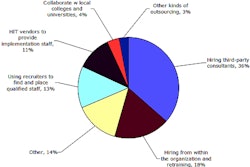
How does a radiology department in a large children's hospital with nine offsite imaging locations manage urgent and critical results reporting efficiently? Researchers from Cincinnati Children's Hospital describe how they do it in an article published online this month in the American Journal of Roentgenology.
The Ohio hospital manages the process through a centralized physician customer service department operating 16 hours a day, seven days a week. Customer service representatives in the department answer calls to the radiology department and convey radiology results, freeing radiologists to perform other tasks (AJR, January 2011, Vol. 196:1, w48-w51).
The authors note recent studies indicating that poor communication of results is a causative factor in 70% to 80% of malpractice lawsuits. In many cases, radiologists attempted to contact referring physicians but did not document their communication.
To improve communication, Cincinnati Children's created the customer service department in August 2005, and the hospital linked department staff to the department's workflow via an interface between its workflow management software and clinical order-entry system.
Referring physicians are able to request that they be personally notified of exam results, regardless of the findings or level of urgency. When such a request is made, a telephone icon in the worklist indicates that the ordering physician wants to be notified personally of the results. As soon as findings are dictated and the report is electronically signed, an entry is added to the notification worklist managed by the customer service department.
When an entry is opened, a form displays the name and telephone number(s) or other contact preferences information, such as a pager or fax number, and the contents of the complete report. The form has fields for the staff to document in detail all communication attempts, and a date-time stamp is automatically added to each entry.
 |
| Button strip at the top of patient files to request doctor-to-doctor communication or telephone notification of report. Clock indicates that patient is waiting. Reprinted with permission from Towbin AJ, Hall S, Moskovitz J, Johnson ND, Donnelly LF. Creating a comprehensive customer service program to help convey critical and acute results of radiology studies. AJR 2011; 196:158' [web]W48-W51. |
The clerical staff communicates reports of urgent and unexpected critical findings by phone or fax. They also communicate report results of radiology exams for which an ordering physician has requested personal notification. This represents 12% to 14% of the total number of exams performed annually, which in 2010 was approximately 225,000.
When a radiologist activates a symbol that indicates he or she needs to speak personally with the referring physician, the customer service department is the single source for placing and receiving calls. This is efficient for referring physicians, who call a central telephone number, and for radiologists, who are not interrupted until the physician is on the line.
Lead author and pediatric radiologist Alexander Towbin, MD, and colleagues acknowledge that the cost to staff and operate the physician customer service department is not unsubstantial. However, in the opinion of radiologists, the benefits outweigh the costs.
"The cost is offset by the improved efficiency of radiologists, who are the most expensive part of the workflow chain," Towbin said. "Customer service representatives, who are entry-level employees, relieve radiologists of some of the administrative tasks, allowing them to maximize their time reading imaging studies, conducting research, and teaching."
By Cynthia E. Keen
AuntMinnie.com staff writer
January 12, 2011
Related Reading
Critical results reporting process improved in Ky., November 18, 2010
What clinicians want in a critical results reporting system, November 18, 2010
System automates delivery of nonurgent findings for rads, October 15, 2010
Critical results reporting -- it's cheaper than settling lawsuits, June 5, 2009
Copyright © 2011 AuntMinnie.com



















